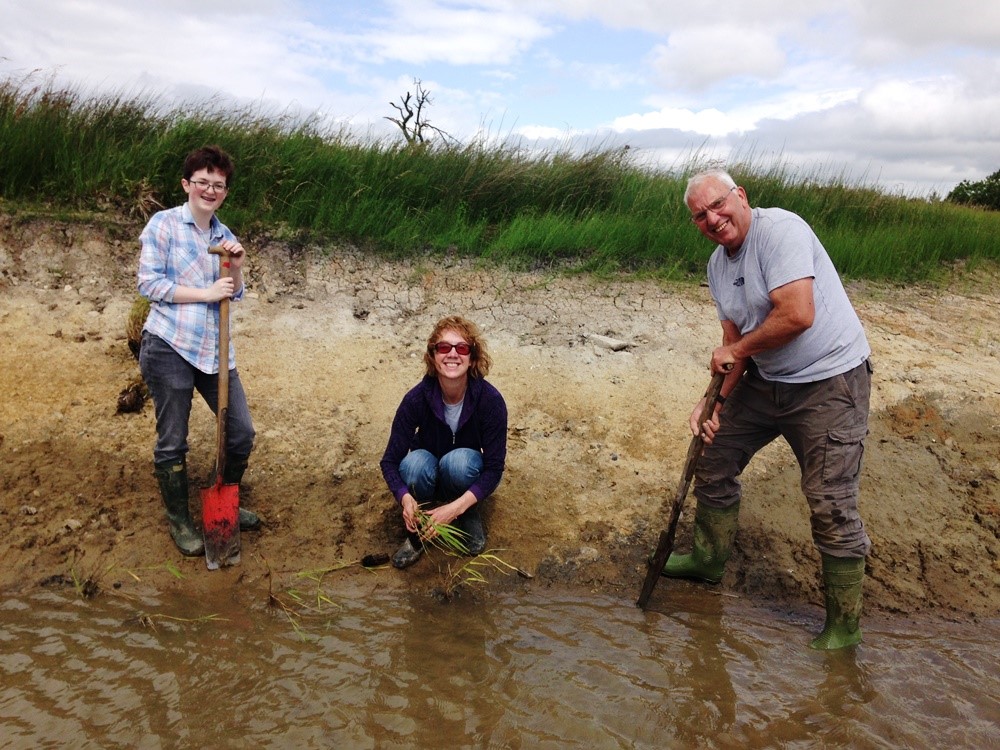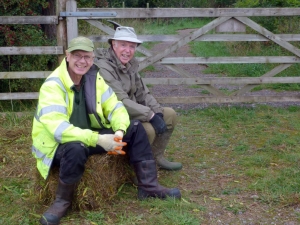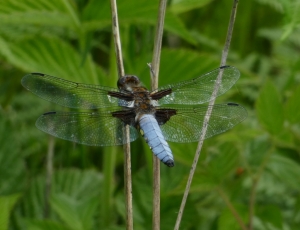Blog Archive (24) Posts Made in October 2013
Go Batty for Halloween!
Thursday, October 31st 2013
Families visiting the reserve today found lots of spooky nature themed arts and crafts activities to enjoy. Grace was happy to show off her decorated pumpkin biscuit briefly, before eating it!
The families enjoyed making origami bats as they were learning about these fascinating nocturnal creatures.
Displays were set up for the children to find out more about the lives of the creatures they were making, as well as the pumpkins and Halloween decorations.
Thank you to everyone who helped us out with this event, setting up the Field Centre and leading activities this morning.
What did you spot?
Wednesday, October 30th 2013
The monthly flower survey was done this morning; 27 species, including Honeysuckle, Knapweed and Ivy were recorded, a good number for the time of year.
It was noticed how many 7-Spot Ladybirds were beginning to group together along spikey twigs and in Gorse bushes as they make a search for a place to hibernate. The spiked bushes offer them some protection from hungry winter predators.
With the wonderful calm weather it is an ideal opportunity to finish the autumn strimming on the wetland. Both Adam's were hard at work up there this morning to clear the last of the invasive coarse rushes and gorse. These will be raked up and cleared in due course. Both Jack Snipe and Snipe were seen here during the day.
Finally, don't forget about our Go Batty half term Halloween event tomorrow morning. Join us in the classroom from 10am for some spooky arts and crafts activities!
The Tuesday Gang
Tuesday, October 29th 2013
In the glorious late autumn sun, volunteers got stuck into a day of willow coppicing. This area of the reserve had become very dense and closed in. We also wanted to reduce the height of the trees to encourage overwintering birds to come down and feed on the many hawthorn berries and other fruiting bushes found here.
The picture above shows the site at the beginning of the day. Good progress was made through the morning and a fire was started to get rid of the brash. Some of the larger stems were moved to the stone pile ready to be chipped for use around the reserve.
By the end of the afternoon we had created a glade, returning the coppiced area to an earlier stage of succession.
We have achieved a lot here today and as always our thanks go to the volunteers who have worked hard to improve the quality of habitats on the reserve.
Ringing Recoveries
Monday, October 28th 2013
The interactive map shows a selection of the bird ringing recoveries we have received from the BTO between August and October this year. Red lines represent birds ringed elsewhere and controlled by the Swaledale Ringing Group, while blue lines represent birds ringed by the Swaledale Ringing Group and controlled elsewhere. You can zoom into the map and to find out more information about a recovery click on the coloured line.
One particularly good recovery was of a Storm Petrel ringed at Cape Wrath in June 1993, and then controlled on Priest Island in June 2013, making this small pelagic bird over 20 years old! This particular bird was caught again in 2005 and 2009. Hopefully it will not be the last we see of it! These are some of the smallest sea birds, coming to land only to breed in the summer months when they create shallow burrows or nest in crevices in rocks and scree.
If you want more information about bird ringing and recoveries be sure to check out the BTO Online Ringing Reports, where you can find out about ringing totals and summaries of ringing recoveries by species and county.
What happens to our insects over winter?
Sunday, October 27th 2013
We know as autumn approaches, Chiffchaffs and Willow Warblers leave Foxglove and join the yearly migration south. Amphibians head towards their hibernation sites on the reserve, even those tiny ones who have just left the pond this summer. This small Common Toad had to be rescued as it was walking across the access road!

But what happens to the insects? The Peacock butterfiles we see in spring often look a little worse for wear as they have spent the cold winter months in hibernation. As the temperature rises these butterflies feed and then find suitable places to lay their eggs. Caterpillars pupate and newly hatched adults can be seen on the wing from July.

Many insects find the Fleabane flowers a good source of food. However, to date, Speckled Wood has not been one of them. According to information they enjoy Fleabane. (A quest for next year?) They do enjoy the sunny open glades and woodland edeges, where the males defend their territories and mate with females passing through. This is one of the few insects that can spend the winter either as a caterpillar or a pupa. Adults can emerge from April.

At this time of year the world of the spider is easily seen as thier webs are covered in dew and rain drops. The female orb web spider lays her eggs, leaving them in an egg sac over winter. They hatch in the spring. She dies with the first frosts.

Seven Spot Ladybirds are now moving to their hibernation sites, in the middle of the Gorse, where they will be protected from predators.

Although few insects are seen overwinter, they all have ensured, by different strategies, that they will be on the wing next year.
Wild Things!
Friday, October 25th 2013
Flocks of Redwing are still to be seen over the reserve. They are feeding on the abundant Hawthorn berries throughout the area. These small thrushes have a creamy strip above the eye and an orange-red flank patch which make them distinctive. They are migrants and arrive from September, with most in October and November. They leave again in March and April, although occasionally birds stay later.This juvenile was caught and ringed at Foxglove this week.

A display about Foxglove will be on show at the Station in Richmond on Sunday. This is alongside Project Wild Thing. The project has produced a film which is currently being launched nationwide. The film will be shown at the Station cinema this weekend and there will be information about local places where children are encouraged to learn about nature and enjoy the great outdoors.

Over half term there are plenty of self guided activities for families to enjoy. Pop into the classroom before you head out on a walk and pick up some quizzes and challenges to entertain the children. On Thursday morning there will be a drop in arts and crafts session with spooky spiders and bats to make and take home. See you there!
New Scooter
Thursday, October 24th 2013
Our thanks today go to Eden Mobility in Darlington who have very generously donated a mobility scooter to the reserve. We are very grateful for this and are sure it will soon be put to good use along the easy access trails, allowing less mobile visitors to get to the hides and enjoy the wildlife on offer.
Otterly Wonderful!
Wednesday, October 23rd 2013
Ken has been setting his remote camera at various locations around the reserve for over two years in the hope of capturing some photographs and videos of the more elusive wildlife found here. Since otters were spotted by Sophie and Adam a few weeks ago along the beck running from the lake his efforts have been concentrated in this area.
After several weeks trying, with no otter shots we had got used to checking the footage and seeing nothing. This week was different! We loaded it onto the computer and were first pleased to see a Heron feeding, then Grey Wagtails, and finally two Otters moving along the beck, feeding and playing.
We are very grateful to Ken for his perseverance to get this fantastic footage, we have asked him for some film of Water Voles next so make sure to keep checking the blog for this!
Woodland Work and Fame at Last!
Tuesday, October 22nd 2013
Clearing trees that are 'under the canopy' is an important part of woodland management. Thinning out small trees allows the larger healthier ones to thrive and lets more light reach the ground to benefit ground flora. This was the main task for 'Team Tuesday' who were so keen that the work was complete by lunchtime!
.jpg)
Logs were added to a habitat pile and brash was burned on a fire that will hopefully stay hot enough for the Eco Club bonfire cookery session on Saturday. Fingers crossed!
.jpg)
A stunning example of Fly Agaric (Amanita muscaria) was found close to the work site. This quintessential toadstool adds a bright splash of colour to the woodland floor at this time of year.
.jpg)
This time last week, Dave from BBC Tees interviewed staff and volunteers for the Sunday gardening radio slot. The interview can be heard on BBC iPlayer and starts at 1:36:30.
The closing date for the quiz is 1st November .There is still time to take part. Please send in your entries even if you can't find all of the answers as it is great feedback for the quiz masters!
Finally, Redwing have continued to pour over the reserve in large flocks and a Red Admiral was seen on the wing.
Bird Ringing
Monday, October 21st 2013
Once the nets were raised and a cup of tea was drunk, a lesson on the switching on of the tape lure was given by Tony.

There was concern that Blue Tits had not had a good breeding season, but today there were increased numbers passing through the ringing room. Some of these birds will be moving into Foxglove for the winter, from the surrounding woodlands. Bullfinches also saw an increase in numbers, some still in post juvenile moult. Tree Creeper, Wren and Goldcrest also made an appearance.
Amongst the birds returned from the last net round were a Kingfisher, a Sparrowhawk and a Great Spotted Woodpecker. Is this the Kingfisher that visitors have been watching, on the Lake, over the last few weeks? It will be interesting to see if it is caught again.

Tony pointed out the diagnostic features of the juvenile male Sparrowhawk. Sparrowhawks breed late in the season so ensuring that their young have a plentiful supply of other young birds as they become independent.

By the end of the day over 150 birds had been processed, 91 of them being new birds.
And finally - gentlemen were outnumbered today!

Amazing!
Saturday, October 19th 2013
Yesterday in the damp but not too cold weather this moth was found sitting on the notice board outside the Field Centre. It is one of the Epirrita species of moth. On closer inspection you can see that it has, what appears to be hairs, along the edges of its wings.

It will be interesting to look at other moths to see if they too have this feature. Many have furry bodies and hairy legs, like this Canary-shouldered Thorn.

Green-brindled Crescent moths not only have furry bodies but furry striped legs.

Are You Sitting Comfortably?
Saturday, October 19th 2013
Protection is a requirement for winter hibernation, but it must be a little uncomfortable in the Gorse for this 7 Spot Ladybird.

Not sure who was the most comfortable and safe, the Eyed Ladybird on the bridge handrail or the greenfly sitting on the ladybird!

Yesterday's warmth and sunshine brought out darters and butterflies. They were looking for places where they could receive maximum heat. This did not necessarily mean the most comfortable or photogenic places.
The wheelbarrow waiting to be loaded, proved an ideal site for this darter to receive a bit of warmth.

Whilst another chose the vertical side of the boardwalk.

In the back garden the butterflies were feeding from the late flowering Michealmas Daisies,

but one decided it was much better to hang onto the webbing in front of the activity room window.

And finally we have mentioned several times that we feed apple to the Water Voles. (Thank you to everyone who provides us with apples.) We know they are there because the apple disappears and in exchange they leave their droppings. Today a little more evidence that they are present was the piece of apple with teeth marks, left on the board.

Ponds and Preparations
Friday, October 18th 2013
A new pond-dipping platform is due to be constructed in the series of pools in the Willow Carr. This new platform will have wheelchair friendly access like the existing ones and will allow the pondlife to develop as only two platforms (out of three) will be used in a summer season. This rotation will benefit the pond wildlife. Work began today and the chosen pool was re-profiled in preparation.

Close by, volunteers helped to remove cuttings from a large glade that had been brushcut in order to encourage more wildflowers to grow. As you can see care was taken to leave the delicate ferns intact!

Brambles and grasses were also cut down and raked off in the newly planted orchard. A wildlife corridor was left in between the two cut areas for small mammals, amphibians and invertebrates.

A log pile remains as an ideal habitat for the animals mentioned above.

Team Thursday carried out many tasks in addition to the raking. They dug out overgrown dams, removed barley straw bales from ponds (these had been preventing the growth of algae during the summer months), weeded out invasive New Zealand pondweed and welcomed visitors.

Thank you to everyone involved today and also to Tony and Adam who toiled in the torrential rain yesterday afternoon in the glade and orchard. Elizabeth led a guided walk to look at the Autumn flora and fauna (amongst numerous other jobs) and found plenty to see.
The Kingfisher has been showing off on the lake and large flocks of Redwing have been seen throughout the day. There are still some flowers and butterflies hanging on to the last few days of Autumn. Devil's Bit Scabious continues to add a dash of colour to path edges and a Peacock butterfly was spotted today.
To assist with coffee mornings, a team of volunteers is being sought. Please get in touch if you would like to be included. The new 'Team Cappucino' will be dedicated to maximising this fundraising opportunity! It will involve varied tasks such as serving teas, selling cakes and Foxglove items, running raffles and tombolas, washing up, drying up and spreading the word about the reserve and its wildlife. The next coffee morning will be in Richmond Town Hall on Thursday 14th November.
Collections are now being made for the Christmas hamper. If you have any suitable food items that you would like to donate then please bring them into the Field Centre. Raffle tickets are on sale and the winner will be announced at the Christmas party on Wednesday 18th December. Why not make use of a 'Buy One Get One Free' offer and donate the free item. Christmas cards and calendars are also on sale in the centre. 'Tis almost the season to be jolly “fa la la, la la la, la la la”!
Priceless!
Tuesday, October 15th 2013
Volunteers are unpaid, not because they are worthless, but because they are priceless! Once again the Tuesday troop completed a huge task and made a big difference to the reserve. The fenceline between the nature reserve and the army barracks needed to be cleared. You can see from the photograph below just how many branches were cut back! These will be shredded with a woodchipper in the near future and will be recycled as woodchippings on a path surface or used as mulch in the newly planted orchards.

Volunteers are the backbone of Foxglove Covert and so far this year they have given 1,687 days of their time. In monetary terms this equates to a whopping £84,350.00. This is how much money that volunteers have saved the reserve through their help in practical conservation tasks alone.

Later in the day volunteers were able to chat to Dave from BBC Tees who was interested to learn why they feel so passionate about the reserve and how much they enjoy being part of the Foxglove team. The interview will be on BBC Tees this Sunday from 10.00am onwards.

Thank you to all who helped out today and to pupils from the Dales School who assisted with today's task.
Species List Update
Sunday, October 13th 2013
Over recent months Richard Witham has written a computer programme which enables us to enter surveys, reports, new species and also record the monthly observations. As with all new programmes it has had hiccups but hopefully we are now past that stage and data has been entered up to the end of 2012. The number of species recorded at Foxglove now stands at 2269
This year, 2013, has seen several other new species recorded and these are still waiting to be entered. The next big task will be to enter all the data from the Bioblitz weekend and the number of species will increase.
Writing this programme has required a great deal of time and work. Entering the data is time consuming, but it will benefit Foxglove Covert. Thank you to those who have spent time with the species list.
In a separate data bank we have records of the 103,000 birds caught and ringed in and around Foxglove since 1992. This gives us, amongst other things, details of longevity, survivability, site fidelity, productivity and arrivals and departures of migrants. All of this data is sent to the BTO and is considered to be the second best CES data set in the country.
To those who go 'rooting', the members of the monthly flower walk, the 'moth-ers' who identify all our moths and the ringing team, many, many thanks for all your hard work.
Some members of the flower walk team examing a fern frond that Ann had found after a scramble up the beck side.
.jpg)
The 'moth-ers' - moths, identified ones to the left, still to do to the right.

The bird ringing team at dawn at the Crater.

The Lake
Sunday, October 13th 2013
The Lake is at its best at dawn with pink sky, mist over still water and autumn reflections. Today it was grey! Even the trees looked grey!
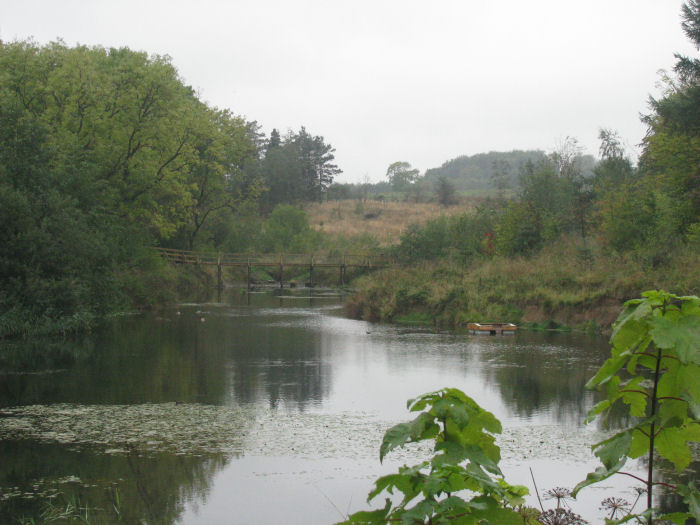
However activity on the Lake made for a much brighter day! There were four female and three male Mallard swimming and bathing across the Lake. Moorhen were totally unperturbed by their antics. Then a flash of blue as the Kingfisher appeared! It flew backwards and forwards between the various perches purposely put out for it. Small tree branches overhanging the water were also used, as it dived for food.
Whilst following the Kingfisher another bird was seen on the Lake and on closer inspection this was identified as a juvenile Little Grebe, sometimes known as a Dabchick. It was diving for food and it caught several fish.
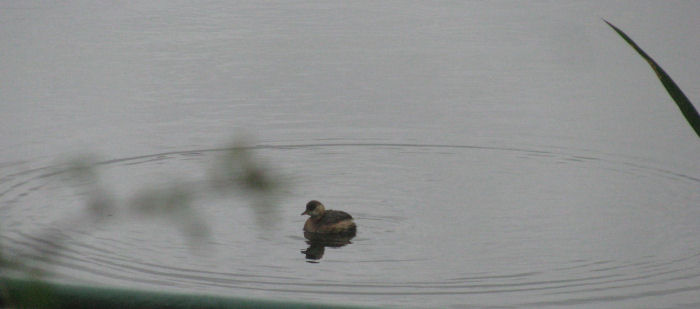
Volunteers were at Tesco today, raising funds and increasing awareness of the reserve. Many thanks to everyone who gave their time to help out.
Upcoming Events
Friday, October 11th 2013
Autumn and winter are going to be busy here on the reserve; there are several guided walks planned over the coming months, starting with Elizabeth’s Autumn Walk this coming Thursday (10am start) – she will be looking at how the seasons are changing and taking you to some of the most photogenic spots so be sure to bring along a camera!
Our Fungal Foray lead by naturalist Keith Thomas is on Saturday 19th (2pm). Fungi are prolific across the reserve just now, with several new species for the reserve discovered over the past fortnight! How many will Keith be able to find? Come along and find out!
Looking further ahead we have a fundraising coffee morning in Richmond Town Hall on Thursday 14th November. If you can spare an hour or two to help run this or provide goodies for the cake stall or a raffle prize please get in touch with Sophie or Adam.
Our Christmas Dinner is booked for Wednesday 18th December (7pm) at Wathgill. The food is always fantastic and we will again have Compass Rose providing entertainment for the evening as well as quizzes and a raffle! Tickets for this event are just £12 per person so please book if you would like to come – the more the merrier!
Full details and booking forms for all our events are available on the events page. See you at one soon!
Sprucing up the reserve
Wednesday, October 9th 2013
Contractors have been hard at work upgrading some of the path network running through the reserve. Surfaces have been refreshed on many of the paths where they have been breaking up over time and succumbing to subsidence. The new level surfaces should make it much easier for visitors to navigate around the site.
Over time as trees along the beck have grown, flyways used by Kingfishers, Dippers and Grey Wagtails have become overgrown and impassable. Several have been felled this morning to open this route up and encourage more birds to use the beck to feed and breed.
The contractors have been careful, minimising disturbance here as they work. The logs are being removed from the beck and used to create habitat piles which will create refuges for amphibians and invertebrates looking for places to hibernate. The brash, in due course will be chipped and used to infill some of the woodland pathways which were edged last winter.
Thank you to everyone from Staley Stonework who have been involved in these projects!
Autumn Jobs
Tuesday, October 8th 2013
The Belted Galloway cattle and Herdwick sheep have spent the summer grazing the moorland to help us to manage the wildflower habitats found here. As autumn is on its way and the supply of fresh grass is dwindling we said goodbye to them yesterday as they returned to the farm. They have done a very good job keeping check of the coarse grasses which otherwise would dominate this beautiful area.
Volunteers found themselves working on the wetland. Over the past few weeks the bunds have had their autumn cut; this was raked up and burned. This is done to help control rushes which have spread across the area, outcompeting some of the more delicate wildflowers and grasses.
Thank you to everyone who has been involved during this task, the wetland is looking great and we are looking forward to seeing the benefit of this work next spring and summer!
Something a Bit Different
Monday, October 7th 2013
Some of the Foxglove ringing team (Swaledale Ringing Group) had an opportunity to join in with a cannon netting session at Teeside at the weekend. This is a well practised and licensed method of catching water birds by firing a net out onto the shore. Amongst the birds caught were Teal, Wigeon and Redshank. Once extracted from the net, the birds were held in a custom built run ready to be ringed.

To see and handle different kinds of birds is a valuable training opportunity for the bird ringers. Eric from Teeside Ringing Group explained how the biometrics are measured on the different species. Below Lesley and Eric are ageing a Redshank by its plumage.

Some of the younger members learned how to handle ducks for the first time.

Once the rings had been fitted onto the birds legs they were released back into the wild. One day we might learn where these Wigeon migrate to and how long they live for. Eleanor won the coveted 'best hat' competition.

As the team were leaving and packing up the equipment, a Snow Bunting was spotted sitting on a dismantled cannon!

Our sincere thanks to Robin and Judith from the Wash Wader Ringing Group and all of the members from the Teeside Ringing Group and East Dales Ringing Group who contributed to the session.

And a final photograph - Sophie waiting patiently with flask and a suspiciously empty cake tin!
Autumn Colours Just
Sunday, October 6th 2013
Autumn and its colours are coming slowly to Foxglove. Leaves are beginning to fall, covering not only the paths but the rocks in Risedale Beck too.
.jpg)
.jpg)
The deciduous Larch is just turning to golden yellow.

Hawthorn trees can readily be picked out across the reserve as they are now covered with red berries.

Hopping to Hibernation!
Friday, October 4th 2013
Whilst out and about this week, many of our amphibian friends have been spotted on their journey to find a suitable place for hibernation. This Common Toad seemed to be enjoying the heavy rain showers!

Hoppy weekend from the Foxglove Team!
Fabulous Fungi
Thursday, October 3rd 2013
The moist mild weather that we have experienced this autumn has provided ideal conditions for fungi. A quick walk around the woodland trail and you are sure to see the beauty and variety of these autumnal visitors.
Already this month volunteers have identified over 25 different species, with more being found on each trip out from the field centre. Hand lenses, knives, spore prints and several lengthy debates have all featured so far in the identification process. Below are some of the fungi we have found -
Green Elf Cup

The mycelium growing through the wood stains it a vivid green colour, the stained wood is a common sight in woodlands, though the fruiting bodies are rarely found. The ‘green oak’ from this staining pattern was once prized for use in Tunbridge ware.
Blushing Bracket

This is commonly referred to as a Blushing Bracket because there are often shades of pink or mauve on the upper surface. These distinctive brackets can often be seen on Willow in winter months though are present throughout the year in the UK.
Pleated Inkcap

These delicate little mushrooms are very short-lived grassland species. They appear overnight following rain; within 24 hours they will have shed their spores and decayed away leaving little or no evidence of their existence.
Scalycap

Unidentified as yet, this scalycap at first glance is very similar to Fly Agaric. The scalycap however, is much smaller and has a scaly stipe. It has so far been narrowed down to three possible species - Pholiota squarrosa, Pholiota squarrosoides or Pholiota aurivella – any help with a positive identification would be appreciated!
Thank you to all the volunteers who have spent time over the past couple of days crawling through the woodland searching for and identifying these beautiful specimens.
On another note we have a fundraising day at Tesco in Catterick Garrison on 12th October, if anyone can spare time to help or has a suitable prize for the raffle and tombola please get in touch with Adam or Sophie.
Helping the Heathland
Tuesday, October 1st 2013
To ensure that the reserve remains a haven for Water Voles, a mink monitoring programme is conducted. Clay pads are hidden within wooden rafts at various places around the site. The inquisitive mammals would leave their footprints behind in the clay as they walked through the small tunnels if they were living in the area. With some of the rafts in need of repair, volunteers set to work fetching them in and fixing them. One of them had Otter spraint on the roof!

New clay was expertly prepared by Ken who is a 'pie competition winner' and adept at mixing dough!

The team soon made the wooden structures as good as new and put them back out in the becks and ponds.

Meanwhile, Adam cut a swathe of heather on the heathland to encourage new growth next summer. The seed heads were scattered on another area by laying out the cut stems. This will help the heather to spread and improve the habitat.

Volunteers continued with weeding out this patch and removing Gorse, Silver Birch and Hawthorn.

Pupils from the Dales school joined in and by lunchtime over thirty people were assisting with the task.

Thank you to everyone for contributing to the management of this valuable habitat. The associated wildlife such as Nightjar, Woodcock and even the tiny Heather ladybird will all benefit from this work.
There are some special events coming up including a macro photography course on Sunday 27th October and the Foxglove Christmas party on Wednesday 18th December, see the events page for booking details.





.JPG)





.JPG)
.JPG)


.JPG)
